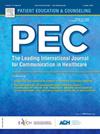新加坡老年人坚持生活方式干预活动以减少认知能力下降和身体虚弱(SINGER)研究:为期一年的过程评估初步分析
IF 2.9
2区 医学
Q2 PUBLIC, ENVIRONMENTAL & OCCUPATIONAL HEALTH
引用次数: 0
摘要
目的:评估新加坡老年干预研究减少认知能力下降和身体虚弱(SINGER)研究的强化干预组对生活方式干预活动的依从性,作为持续过程评估的一部分。该分析确定了与依从性相关的社会人口、心理社会和血管危险因素,以优化干预策略并提高参与者的参与度。方法根据参与者的出席情况,将依从性分为非依从性、低依从性、中等依从性和高依从性。总依从性通过两种方式进行评估,i)所有出席率的综合和ii)潜在类别分析(LCA),以确定基于对SINGER研究活动的依从性的不同参与者亚组。回归模型评估了个体因素对每种干预成分的依从性和LCA得出的依从性概况之间的关联。结果超过70% %的参与者达到中度至高度依从性。LCA确定了三种不同的依从性:低、中、高依从性。参与者对血管和饮食成分的依从性较高,其次是运动成分,对认知成分的依从性较低。女性和受过高等教育等因素与较高的依从性相关,而独居则与较低的依从性相关。高血压患者总体依从性较高,但对血管管理会议的依从性较低。活动的复杂性、提供方式和频率影响依从性,活动越复杂和频繁,依从性越低。结论强化干预组依从性良好。综合分析强调了依从性、社会人口因素和血管风险之间的关系,强调需要有针对性的策略来支持低依从性的亚组并优化参与。实践意义研究小组应该通过简化复杂的活动和为低依从性的亚组量身定制策略来提高参与者的参与度。持续监测依从模式和参与者反馈对于及时调整干预措施至关重要。本文章由计算机程序翻译,如有差异,请以英文原文为准。
Adherence to lifestyle intervention activities in the SINgapore GERiatric to reduce cognitive decline and physical frailty (SINGER) study: A one-year preliminary analysis of process evaluation
Objectives
To evaluate adherence to lifestyle intervention activities in the SINgapore GERiatric Intervention Study to Reduce Cognitive Decline and Physical Frailty (SINGER) study's intensive intervention arm over one year, as part of ongoing process evaluation. The analysis identifies sociodemographic, psychosocial, and vascular risk factors associated with adherence to optimize intervention strategies and improve participant engagement.
Methods
Adherence was categorised as non-adherent, low, moderate and high adherence based on participants' attendance. Total adherence was assessed in two ways, i) a composite of all attendance and ii) Latent Class Analysis (LCA) to identify distinct participant subgroups based on adherence to the SINGER study activities. Regression models assessed associations between individual factors with adherence to each type of intervention component and adherence profiles derived from LCA.
Results
More than 70 % of participants achieving moderate to high adherence. LCA identified three distinct adherence profiles: Low, Moderate and High adherence. Participants showed higher adherence to vascular and diet components, followed by exercise components, and lower adherence to cognitive components. Factors such as being female and having higher education were associated with higher adherence while living alone was associated with lower adherence. Participants with hypertension had higher overall adherence but lower adherence to vascular management sessions. The complexity, delivery mode and frequency of the activities influenced adherence, with more complex and frequent activities showing lower adherence.
Conclusion
The intensive intervention arm showed satisfactory adherence. A comprehensive analysis highlighted the relationship between adherence, sociodemographic factors, and vascular risks, emphasizing the need for targeted strategies to support subgroups with lower adherence and optimize engagement.
Practice implications
The study team should enhance participant engagement by simplifying complex activities and tailoring strategies for subgroups with lower adherence. Ongoing monitoring of adherence patterns and participant feedback will be crucial for making timely adjustments to the intervention.
求助全文
通过发布文献求助,成功后即可免费获取论文全文。
去求助
来源期刊

Patient Education and Counseling
医学-公共卫生、环境卫生与职业卫生
CiteScore
5.60
自引率
11.40%
发文量
384
审稿时长
46 days
期刊介绍:
Patient Education and Counseling is an interdisciplinary, international journal for patient education and health promotion researchers, managers and clinicians. The journal seeks to explore and elucidate the educational, counseling and communication models in health care. Its aim is to provide a forum for fundamental as well as applied research, and to promote the study of organizational issues involved with the delivery of patient education, counseling, health promotion services and training models in improving communication between providers and patients.
 求助内容:
求助内容: 应助结果提醒方式:
应助结果提醒方式:


